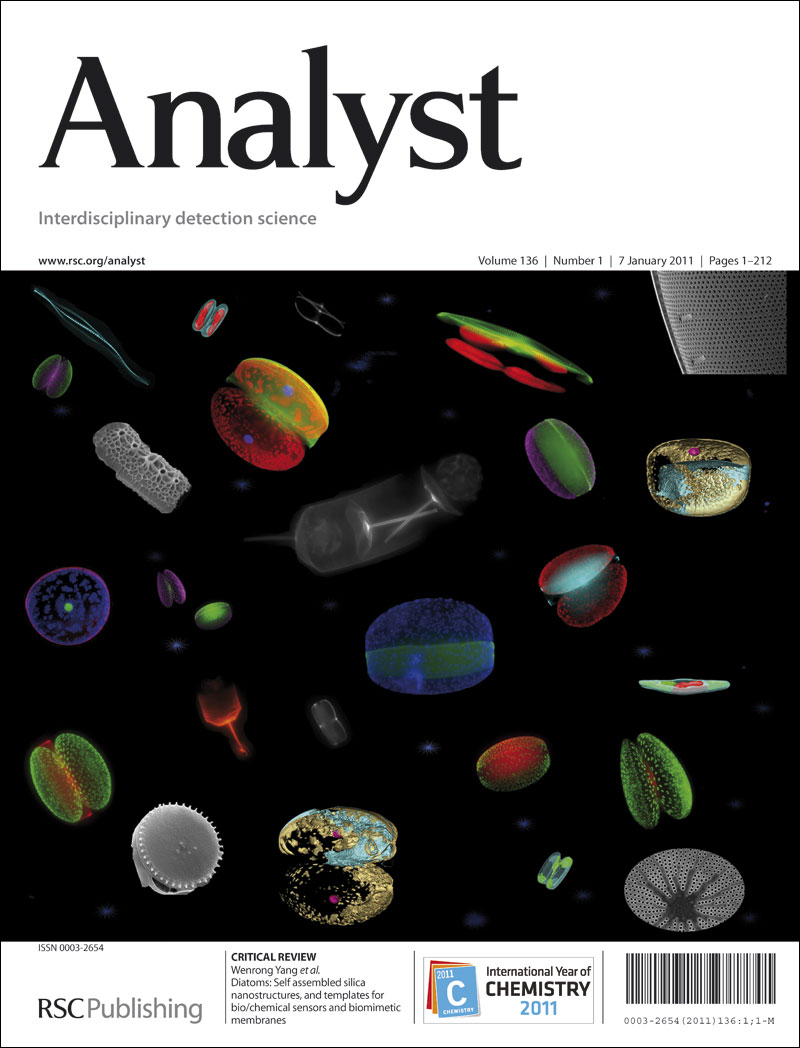将共振能量转移与氧化还原反应相结合用于高灵敏度的葡萄糖电化学发光传感
IF 3.3
3区 化学
Q2 CHEMISTRY, ANALYTICAL
引用次数: 0
摘要
简便、快速监测血糖在临床诊断中具有重要意义。为此,设计了一种简单、快速、高灵敏度的电化学发光(ECL)传感器,用于基于共振能量传递(RET)和氧化还原反应的Glu检测。首先,Ru(bpy)32+包被在树枝状介孔二氧化硅纳米颗粒(RuDMSN,供体)中,涂覆亚甲基蓝(MB,受体/猝灭剂),形成RuDMSN@MB纳米复合材料。将供体和受体结合在一个纳米结构中,可以获得高的RET猝灭效率,从而获得低背景信号和高灵敏度。随后,在碱性条件下,加入Glu,蓝色MB在几分钟内化学还原为无色的亚甲基白(MW),并伴有以约665 nm为中心的吸光度消失。这一氧化还原过程抑制了MB的猝灭能力,从而恢复了发光团的ECL响应。因此,“开启”式ECL传感器将RET策略与氧化还原反应相结合,实现了Glu的快速、灵敏检测。所提出的ECL-RET传感器具有良好的Glu检测效果,检测限为8.1 nM,线性范围为10 nM ~ 100 mM,具有良好的稳定性和重复性。此外,集成RET和氧化还原反应的简易ECL传感器已成功应用于实际样品,展示了其在临床诊断和疾病监测方面的潜在前景。本文章由计算机程序翻译,如有差异,请以英文原文为准。
Integrating resonance energy transfer with redox reaction for highly sensitive electrochemiluminescence sensing of glucose
Facile and rapid monitoring of blood glucose (Glu) is of great significance in clinical diagnostics. Herein, a highly sensitive electrochemiluminescence (ECL) sensor with simplicity and rapidity was designed for reliable Glu assay based on resonance energy transfer (RET) and redox reaction. Initially, Ru(bpy)32+ encapsulated in dendritic mesoporous silica nanoparticles (RuDMSN, donor) was coated with methylene blue (MB, acceptor/quencher) to form RuDMSN@MB nanocomposites. The incorporation of both donor and acceptor within a single nanostructure resulted in a high RET quenching efficiency, leading to a low background signal and high sensitivity. Subsequently, under alkaline conditions, the blue color MB was chemically reduced to colorless methylene white (MW) by the addition of Glu within minutes, accompanied by the disappearance of absorbance centred at about 665 nm. This redox process suppressed the quenching capacity of MB, thereby recovering the ECL response of the luminophore. Therefore, the “turn-on” ECL sensor combined RET strategy and redox reaction achieving rapid and sensitive detection of Glu. The proposed ECL-RET sensor performed well for Glu detection with a detection limit of 8.1 nM and a wide linear range from 10 nM to 100 mM, along with acceptable stability and reproducibility. Furthermore, the facile ECL sensor integrating RET with redox reaction was successfully applied on real samples, demonstrating its potential promise in clinical diagnosis and disease monitoring.
求助全文
通过发布文献求助,成功后即可免费获取论文全文。
去求助
来源期刊

Analyst
化学-分析化学
CiteScore
7.80
自引率
4.80%
发文量
636
审稿时长
1.9 months
期刊介绍:
"Analyst" journal is the home of premier fundamental discoveries, inventions and applications in the analytical and bioanalytical sciences.
 求助内容:
求助内容: 应助结果提醒方式:
应助结果提醒方式:


